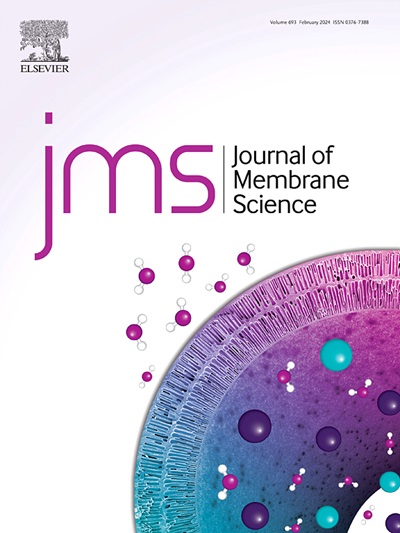Hydrophilic MoS2-Interlayered ceramic supports for high-flux polyamide nanofiltration membranes
IF 8.4
1区 工程技术
Q1 ENGINEERING, CHEMICAL
引用次数: 0
Abstract
The polyamide/ceramic composite nanofiltration membrane has attracted significant research attention due to its combined advantages of excellent mechanical stability from inorganic substrates and superior separation performance from polyamide layers. Nevertheless, there are still technical challenges in performing direct interfacial polymerization on porous ceramic membranes. To address these limitations, this work developed a novel approach using HP-β-CD as a growth modulator for the in-situ synthesis of hydrophilic MoS2 on tubular ceramic substrates, creating a MoS2/ceramic intermediate layer. Subsequently, a high-performance polyamide nanofiltration membrane was fabricated via interface polymerization on the MoS2/ceramic substrate. By systematically optimizing the HP-β-CD concentration in both the precursor solution and aqueous monomer phase, we achieved precise control over both the growth of MoS2 nanosheets on the tubular ceramic substrate and the polyamide layer structure, enabling tunable nanofiltration performance. The resulting PA/M − 3 NF membrane exhibited excellent nanofiltration performance, with high water permeance (23.8 LMH/bar), exceptional Na2SO4 rejection (97.8 %), and remarkable long-term stability and pressure resistance.

高通量聚酰胺纳滤膜的亲水性二硫化钼层间陶瓷支架
聚酰胺/陶瓷复合纳滤膜由于具有优异的机械稳定性和优异的分离性能而引起了人们的广泛关注。然而,在多孔陶瓷膜上进行直接界面聚合仍然存在技术挑战。为了解决这些限制,本研究开发了一种新的方法,使用HP-β-CD作为生长调节剂,在管状陶瓷衬底上原位合成亲水性MoS2,形成MoS2/陶瓷中间层。随后,在MoS2/陶瓷基板上通过界面聚合制备了高性能聚酰胺纳滤膜。通过系统地优化前驱体溶液和单体水溶液中的HP-β-CD浓度,我们实现了对管状陶瓷衬底上MoS2纳米片生长和聚酰胺层结构的精确控制,实现了可调的纳滤性能。所制备的PA/M−3纳滤膜具有优异的纳滤性能,具有较高的水透率(23.8 LMH/bar),优异的Na2SO4截留率(97.8%),以及良好的长期稳定性和耐压性。
本文章由计算机程序翻译,如有差异,请以英文原文为准。
求助全文
约1分钟内获得全文
求助全文
来源期刊

Journal of Membrane Science
工程技术-高分子科学
CiteScore
17.10
自引率
17.90%
发文量
1031
审稿时长
2.5 months
期刊介绍:
The Journal of Membrane Science is a publication that focuses on membrane systems and is aimed at academic and industrial chemists, chemical engineers, materials scientists, and membranologists. It publishes original research and reviews on various aspects of membrane transport, membrane formation/structure, fouling, module/process design, and processes/applications. The journal primarily focuses on the structure, function, and performance of non-biological membranes but also includes papers that relate to biological membranes. The Journal of Membrane Science publishes Full Text Papers, State-of-the-Art Reviews, Letters to the Editor, and Perspectives.
 求助内容:
求助内容: 应助结果提醒方式:
应助结果提醒方式:


